Analysis of Cross-cultural Capabilities for Lotus Company's Expansion
VerifiedAdded on 2022/12/28
|14
|3291
|64
Report
AI Summary
This report provides a comprehensive analysis of cross-cultural capabilities, focusing on the challenges and opportunities presented by globalization. The report uses Lotus Company, a shoe manufacturer expanding into China, Vietnam, and Ethiopia, as a case study to illustrate the importance of understanding cultural differences in organizational culture, management styles, and human resource practices. It explores various layers and categories of culture, including explicit layers, values and norms, and assumptions and beliefs, and discusses the impact of these cultural dimensions on business operations. Furthermore, the report examines Hofstede's theory of culture, including power distance, masculinity/femininity, individualism, uncertainty avoidance, and long-term orientation, and how these factors influence organizational culture and management strategies. The report emphasizes the need for companies to adapt their strategies to align with the cultural norms of different countries to achieve success in the global market. The report also highlights the importance of effective communication and leadership in fostering a strong organizational culture. This report is a valuable resource for students seeking to understand the complexities of international business and cross-cultural management.
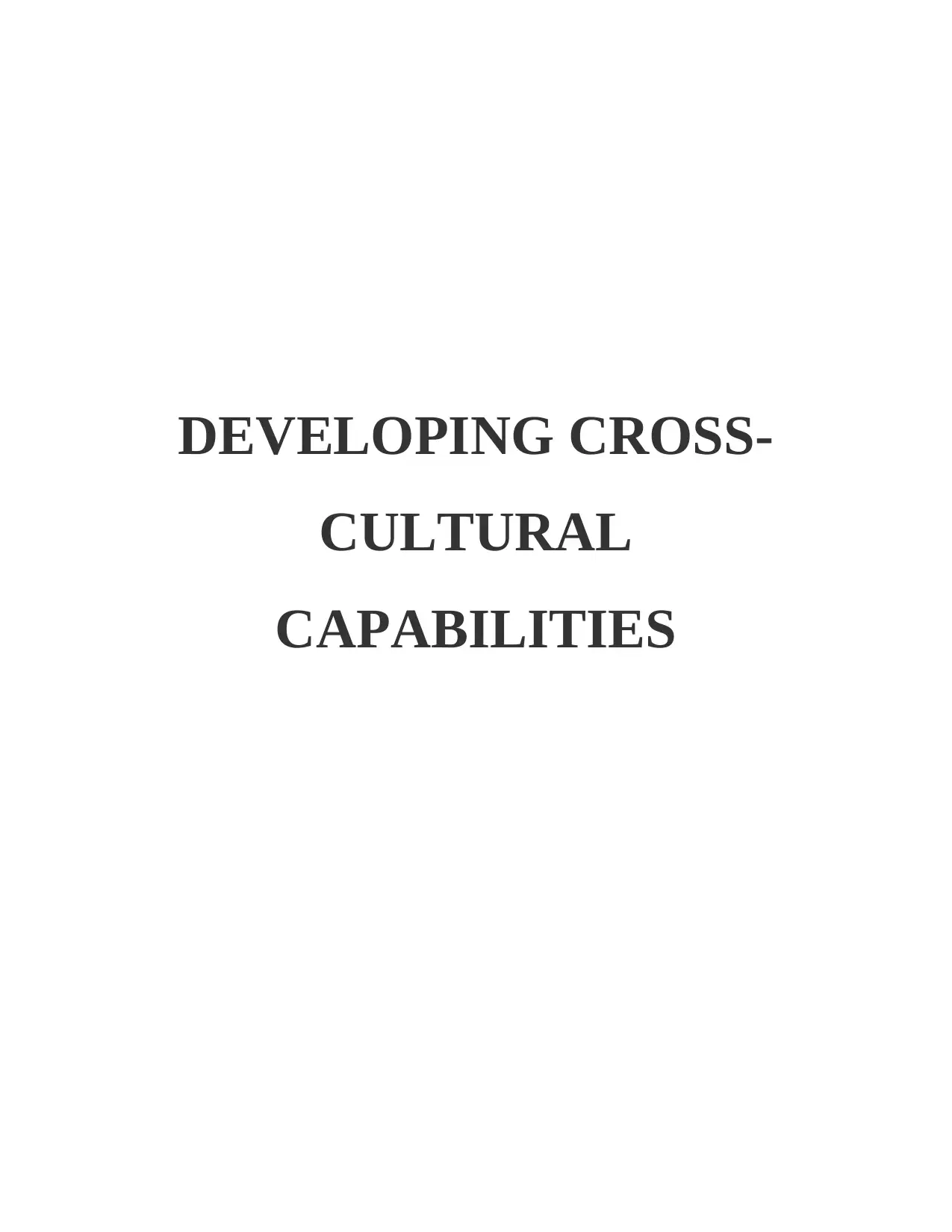
DEVELOPING CROSS-
CULTURAL
CAPABILITIES
CULTURAL
CAPABILITIES
Paraphrase This Document
Need a fresh take? Get an instant paraphrase of this document with our AI Paraphraser
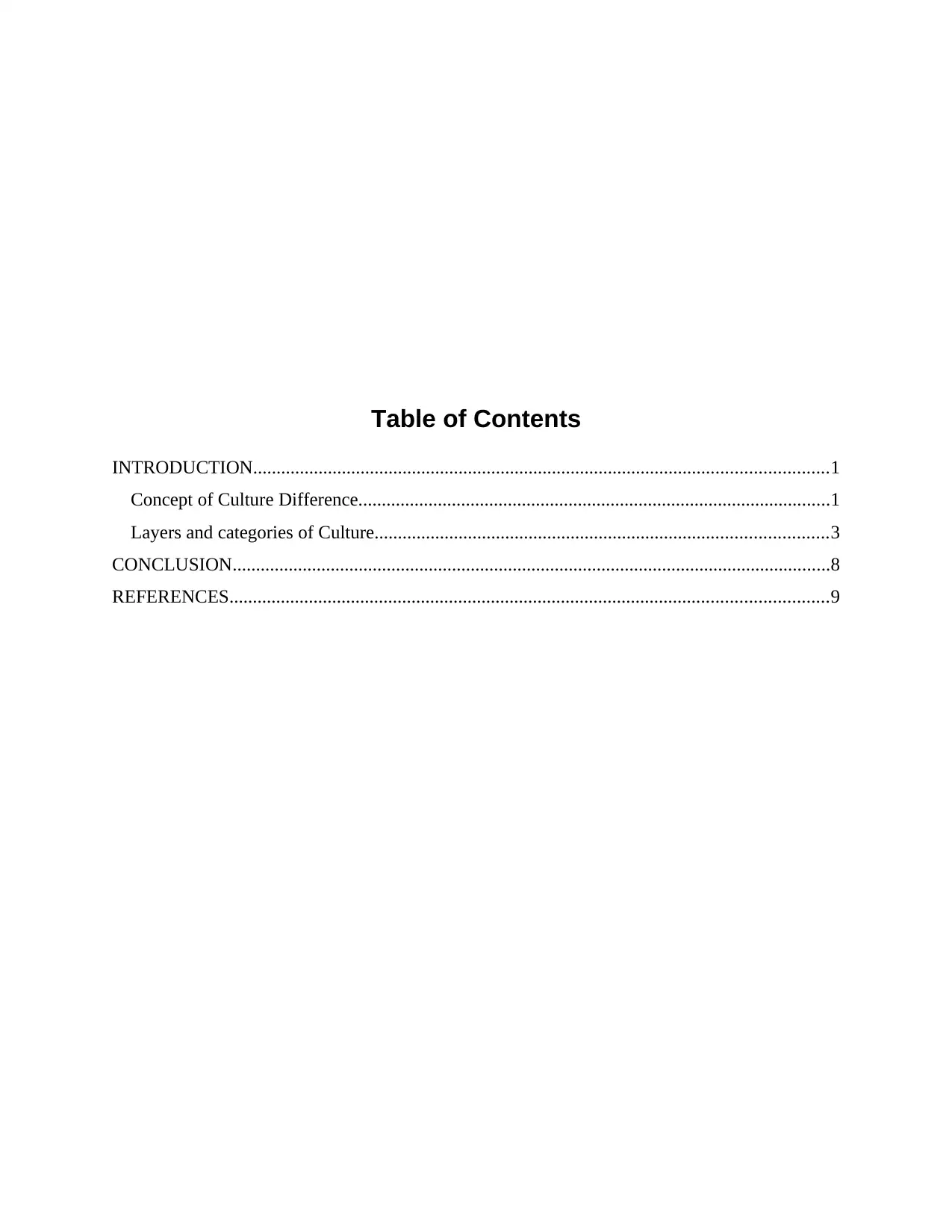
Table of Contents
INTRODUCTION...........................................................................................................................1
Concept of Culture Difference.....................................................................................................1
Layers and categories of Culture.................................................................................................3
CONCLUSION................................................................................................................................8
REFERENCES................................................................................................................................9
INTRODUCTION...........................................................................................................................1
Concept of Culture Difference.....................................................................................................1
Layers and categories of Culture.................................................................................................3
CONCLUSION................................................................................................................................8
REFERENCES................................................................................................................................9
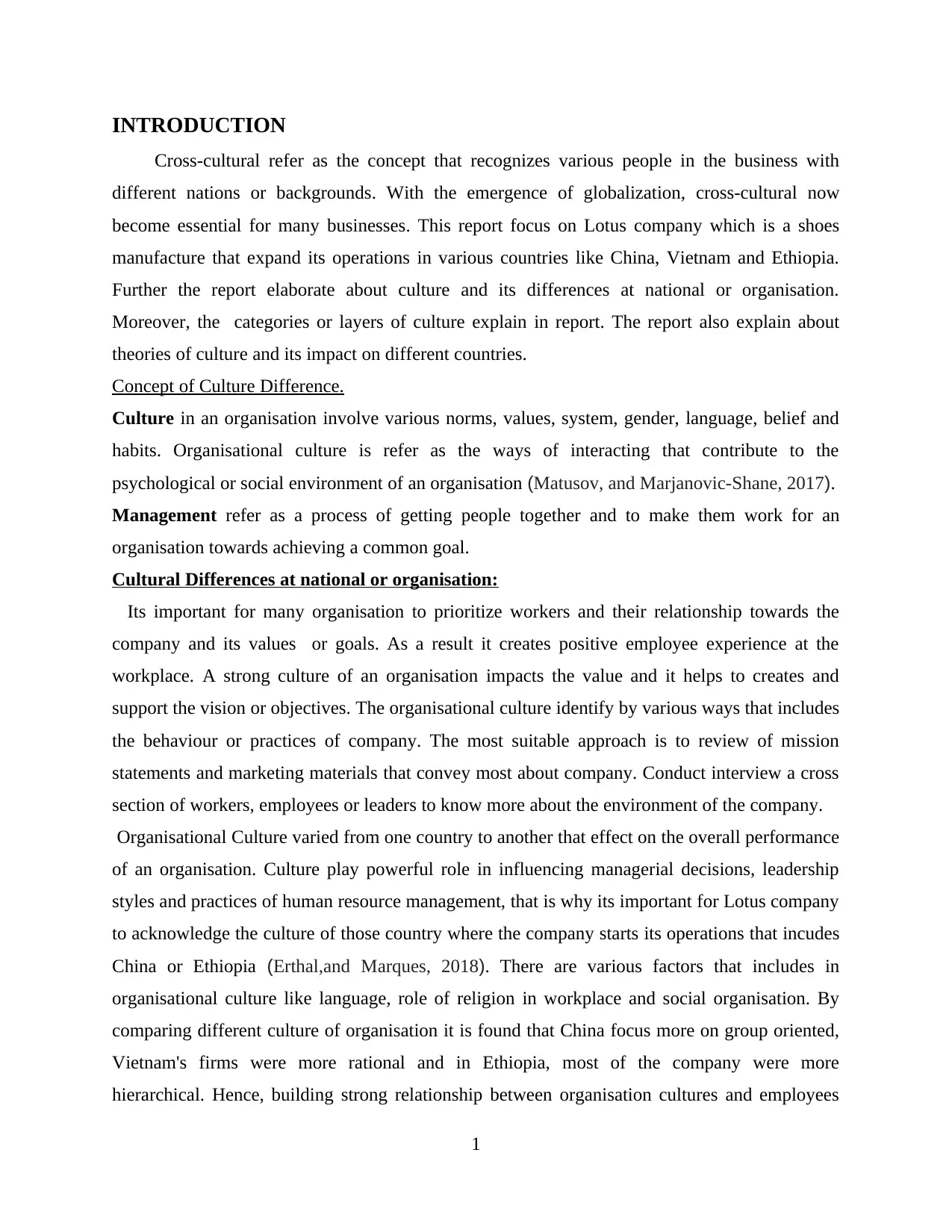
INTRODUCTION
Cross-cultural refer as the concept that recognizes various people in the business with
different nations or backgrounds. With the emergence of globalization, cross-cultural now
become essential for many businesses. This report focus on Lotus company which is a shoes
manufacture that expand its operations in various countries like China, Vietnam and Ethiopia.
Further the report elaborate about culture and its differences at national or organisation.
Moreover, the categories or layers of culture explain in report. The report also explain about
theories of culture and its impact on different countries.
Concept of Culture Difference.
Culture in an organisation involve various norms, values, system, gender, language, belief and
habits. Organisational culture is refer as the ways of interacting that contribute to the
psychological or social environment of an organisation (Matusov, and Marjanovic-Shane, 2017).
Management refer as a process of getting people together and to make them work for an
organisation towards achieving a common goal.
Cultural Differences at national or organisation:
Its important for many organisation to prioritize workers and their relationship towards the
company and its values or goals. As a result it creates positive employee experience at the
workplace. A strong culture of an organisation impacts the value and it helps to creates and
support the vision or objectives. The organisational culture identify by various ways that includes
the behaviour or practices of company. The most suitable approach is to review of mission
statements and marketing materials that convey most about company. Conduct interview a cross
section of workers, employees or leaders to know more about the environment of the company.
Organisational Culture varied from one country to another that effect on the overall performance
of an organisation. Culture play powerful role in influencing managerial decisions, leadership
styles and practices of human resource management, that is why its important for Lotus company
to acknowledge the culture of those country where the company starts its operations that incudes
China or Ethiopia (Erthal,and Marques, 2018). There are various factors that includes in
organisational culture like language, role of religion in workplace and social organisation. By
comparing different culture of organisation it is found that China focus more on group oriented,
Vietnam's firms were more rational and in Ethiopia, most of the company were more
hierarchical. Hence, building strong relationship between organisation cultures and employees
1
Cross-cultural refer as the concept that recognizes various people in the business with
different nations or backgrounds. With the emergence of globalization, cross-cultural now
become essential for many businesses. This report focus on Lotus company which is a shoes
manufacture that expand its operations in various countries like China, Vietnam and Ethiopia.
Further the report elaborate about culture and its differences at national or organisation.
Moreover, the categories or layers of culture explain in report. The report also explain about
theories of culture and its impact on different countries.
Concept of Culture Difference.
Culture in an organisation involve various norms, values, system, gender, language, belief and
habits. Organisational culture is refer as the ways of interacting that contribute to the
psychological or social environment of an organisation (Matusov, and Marjanovic-Shane, 2017).
Management refer as a process of getting people together and to make them work for an
organisation towards achieving a common goal.
Cultural Differences at national or organisation:
Its important for many organisation to prioritize workers and their relationship towards the
company and its values or goals. As a result it creates positive employee experience at the
workplace. A strong culture of an organisation impacts the value and it helps to creates and
support the vision or objectives. The organisational culture identify by various ways that includes
the behaviour or practices of company. The most suitable approach is to review of mission
statements and marketing materials that convey most about company. Conduct interview a cross
section of workers, employees or leaders to know more about the environment of the company.
Organisational Culture varied from one country to another that effect on the overall performance
of an organisation. Culture play powerful role in influencing managerial decisions, leadership
styles and practices of human resource management, that is why its important for Lotus company
to acknowledge the culture of those country where the company starts its operations that incudes
China or Ethiopia (Erthal,and Marques, 2018). There are various factors that includes in
organisational culture like language, role of religion in workplace and social organisation. By
comparing different culture of organisation it is found that China focus more on group oriented,
Vietnam's firms were more rational and in Ethiopia, most of the company were more
hierarchical. Hence, building strong relationship between organisation cultures and employees
1
⊘ This is a preview!⊘
Do you want full access?
Subscribe today to unlock all pages.

Trusted by 1+ million students worldwide
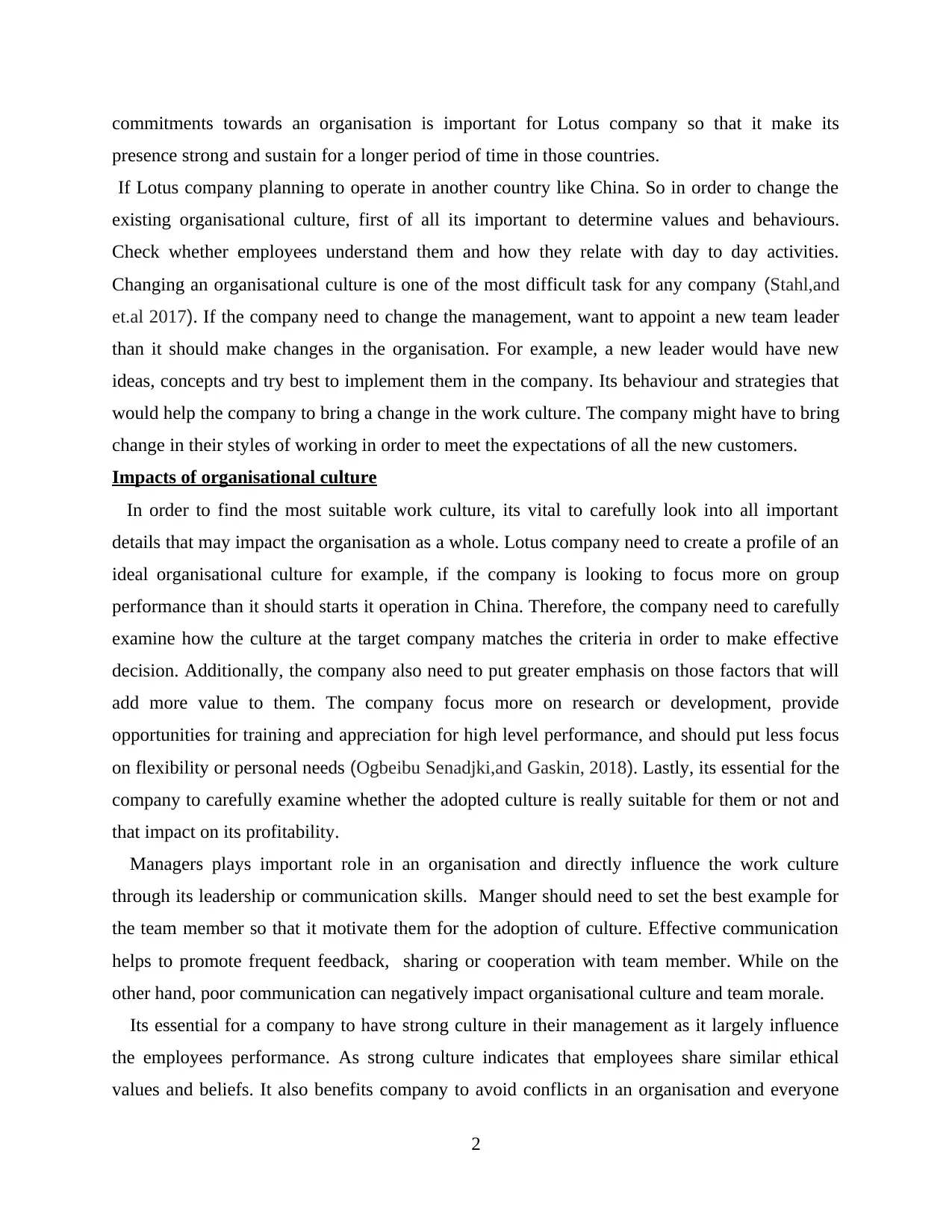
commitments towards an organisation is important for Lotus company so that it make its
presence strong and sustain for a longer period of time in those countries.
If Lotus company planning to operate in another country like China. So in order to change the
existing organisational culture, first of all its important to determine values and behaviours.
Check whether employees understand them and how they relate with day to day activities.
Changing an organisational culture is one of the most difficult task for any company (Stahl,and
et.al 2017). If the company need to change the management, want to appoint a new team leader
than it should make changes in the organisation. For example, a new leader would have new
ideas, concepts and try best to implement them in the company. Its behaviour and strategies that
would help the company to bring a change in the work culture. The company might have to bring
change in their styles of working in order to meet the expectations of all the new customers.
Impacts of organisational culture
In order to find the most suitable work culture, its vital to carefully look into all important
details that may impact the organisation as a whole. Lotus company need to create a profile of an
ideal organisational culture for example, if the company is looking to focus more on group
performance than it should starts it operation in China. Therefore, the company need to carefully
examine how the culture at the target company matches the criteria in order to make effective
decision. Additionally, the company also need to put greater emphasis on those factors that will
add more value to them. The company focus more on research or development, provide
opportunities for training and appreciation for high level performance, and should put less focus
on flexibility or personal needs (Ogbeibu Senadjki,and Gaskin, 2018). Lastly, its essential for the
company to carefully examine whether the adopted culture is really suitable for them or not and
that impact on its profitability.
Managers plays important role in an organisation and directly influence the work culture
through its leadership or communication skills. Manger should need to set the best example for
the team member so that it motivate them for the adoption of culture. Effective communication
helps to promote frequent feedback, sharing or cooperation with team member. While on the
other hand, poor communication can negatively impact organisational culture and team morale.
Its essential for a company to have strong culture in their management as it largely influence
the employees performance. As strong culture indicates that employees share similar ethical
values and beliefs. It also benefits company to avoid conflicts in an organisation and everyone
2
presence strong and sustain for a longer period of time in those countries.
If Lotus company planning to operate in another country like China. So in order to change the
existing organisational culture, first of all its important to determine values and behaviours.
Check whether employees understand them and how they relate with day to day activities.
Changing an organisational culture is one of the most difficult task for any company (Stahl,and
et.al 2017). If the company need to change the management, want to appoint a new team leader
than it should make changes in the organisation. For example, a new leader would have new
ideas, concepts and try best to implement them in the company. Its behaviour and strategies that
would help the company to bring a change in the work culture. The company might have to bring
change in their styles of working in order to meet the expectations of all the new customers.
Impacts of organisational culture
In order to find the most suitable work culture, its vital to carefully look into all important
details that may impact the organisation as a whole. Lotus company need to create a profile of an
ideal organisational culture for example, if the company is looking to focus more on group
performance than it should starts it operation in China. Therefore, the company need to carefully
examine how the culture at the target company matches the criteria in order to make effective
decision. Additionally, the company also need to put greater emphasis on those factors that will
add more value to them. The company focus more on research or development, provide
opportunities for training and appreciation for high level performance, and should put less focus
on flexibility or personal needs (Ogbeibu Senadjki,and Gaskin, 2018). Lastly, its essential for the
company to carefully examine whether the adopted culture is really suitable for them or not and
that impact on its profitability.
Managers plays important role in an organisation and directly influence the work culture
through its leadership or communication skills. Manger should need to set the best example for
the team member so that it motivate them for the adoption of culture. Effective communication
helps to promote frequent feedback, sharing or cooperation with team member. While on the
other hand, poor communication can negatively impact organisational culture and team morale.
Its essential for a company to have strong culture in their management as it largely influence
the employees performance. As strong culture indicates that employees share similar ethical
values and beliefs. It also benefits company to avoid conflicts in an organisation and everyone
2
Paraphrase This Document
Need a fresh take? Get an instant paraphrase of this document with our AI Paraphraser
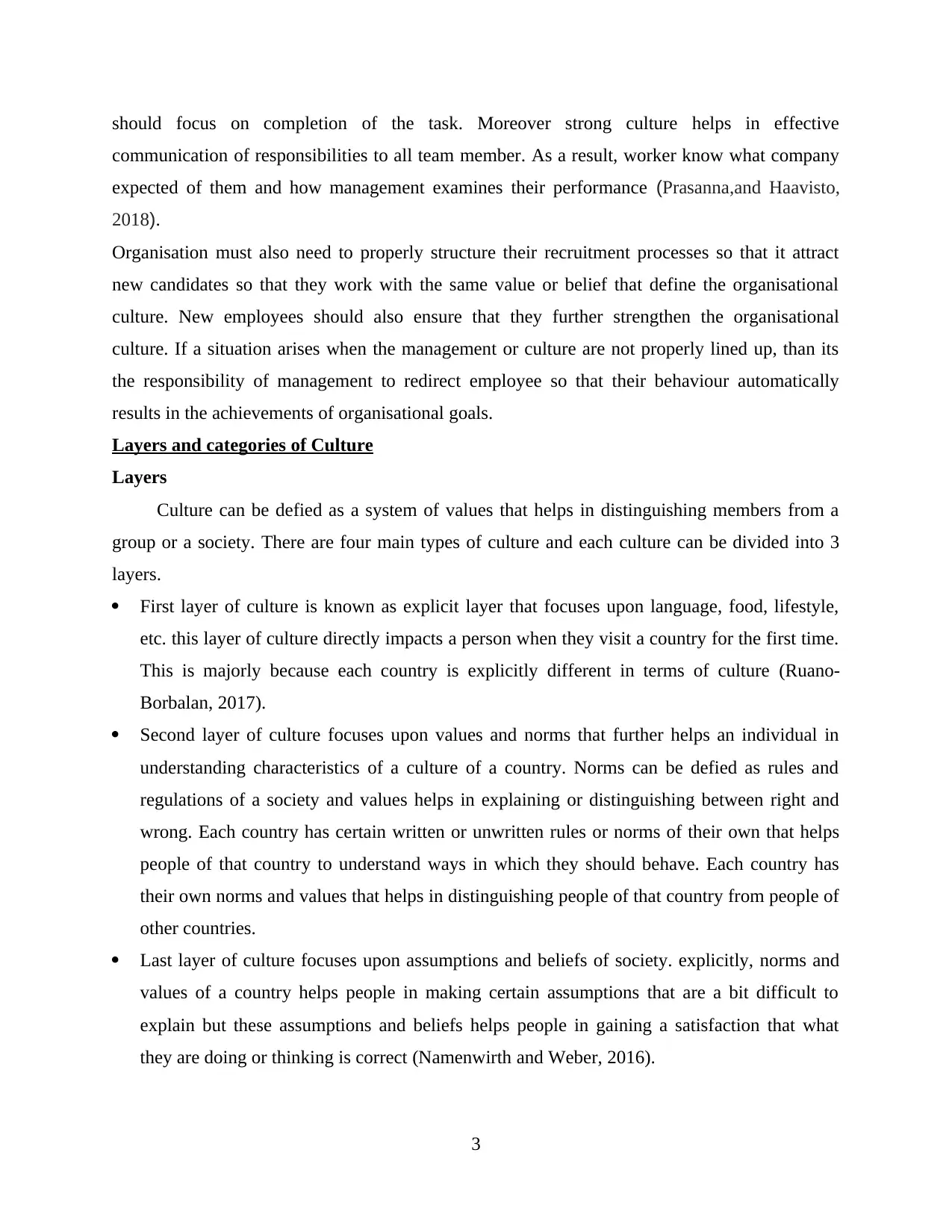
should focus on completion of the task. Moreover strong culture helps in effective
communication of responsibilities to all team member. As a result, worker know what company
expected of them and how management examines their performance (Prasanna,and Haavisto,
2018).
Organisation must also need to properly structure their recruitment processes so that it attract
new candidates so that they work with the same value or belief that define the organisational
culture. New employees should also ensure that they further strengthen the organisational
culture. If a situation arises when the management or culture are not properly lined up, than its
the responsibility of management to redirect employee so that their behaviour automatically
results in the achievements of organisational goals.
Layers and categories of Culture
Layers
Culture can be defied as a system of values that helps in distinguishing members from a
group or a society. There are four main types of culture and each culture can be divided into 3
layers.
First layer of culture is known as explicit layer that focuses upon language, food, lifestyle,
etc. this layer of culture directly impacts a person when they visit a country for the first time.
This is majorly because each country is explicitly different in terms of culture (Ruano-
Borbalan, 2017).
Second layer of culture focuses upon values and norms that further helps an individual in
understanding characteristics of a culture of a country. Norms can be defied as rules and
regulations of a society and values helps in explaining or distinguishing between right and
wrong. Each country has certain written or unwritten rules or norms of their own that helps
people of that country to understand ways in which they should behave. Each country has
their own norms and values that helps in distinguishing people of that country from people of
other countries.
Last layer of culture focuses upon assumptions and beliefs of society. explicitly, norms and
values of a country helps people in making certain assumptions that are a bit difficult to
explain but these assumptions and beliefs helps people in gaining a satisfaction that what
they are doing or thinking is correct (Namenwirth and Weber, 2016).
3
communication of responsibilities to all team member. As a result, worker know what company
expected of them and how management examines their performance (Prasanna,and Haavisto,
2018).
Organisation must also need to properly structure their recruitment processes so that it attract
new candidates so that they work with the same value or belief that define the organisational
culture. New employees should also ensure that they further strengthen the organisational
culture. If a situation arises when the management or culture are not properly lined up, than its
the responsibility of management to redirect employee so that their behaviour automatically
results in the achievements of organisational goals.
Layers and categories of Culture
Layers
Culture can be defied as a system of values that helps in distinguishing members from a
group or a society. There are four main types of culture and each culture can be divided into 3
layers.
First layer of culture is known as explicit layer that focuses upon language, food, lifestyle,
etc. this layer of culture directly impacts a person when they visit a country for the first time.
This is majorly because each country is explicitly different in terms of culture (Ruano-
Borbalan, 2017).
Second layer of culture focuses upon values and norms that further helps an individual in
understanding characteristics of a culture of a country. Norms can be defied as rules and
regulations of a society and values helps in explaining or distinguishing between right and
wrong. Each country has certain written or unwritten rules or norms of their own that helps
people of that country to understand ways in which they should behave. Each country has
their own norms and values that helps in distinguishing people of that country from people of
other countries.
Last layer of culture focuses upon assumptions and beliefs of society. explicitly, norms and
values of a country helps people in making certain assumptions that are a bit difficult to
explain but these assumptions and beliefs helps people in gaining a satisfaction that what
they are doing or thinking is correct (Namenwirth and Weber, 2016).
3
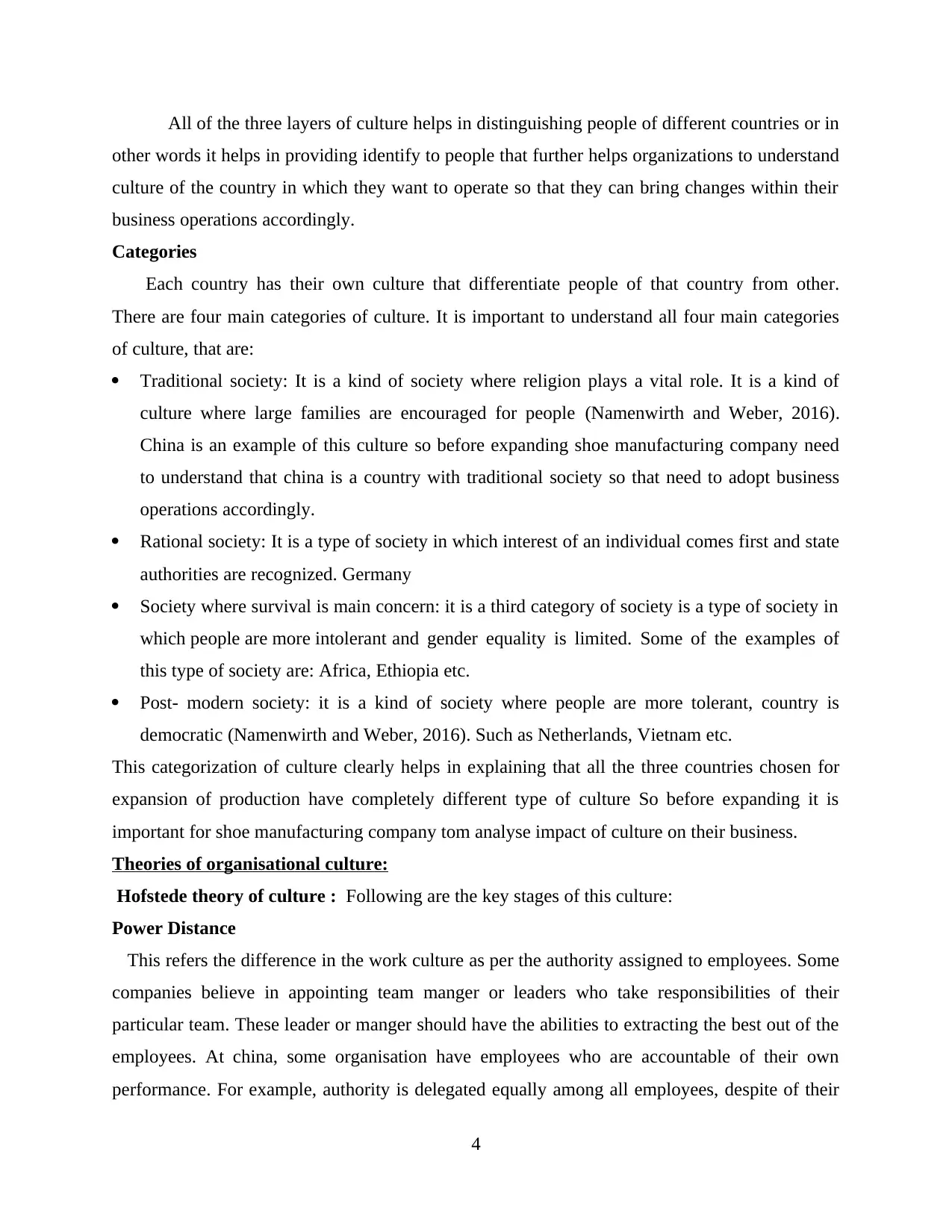
All of the three layers of culture helps in distinguishing people of different countries or in
other words it helps in providing identify to people that further helps organizations to understand
culture of the country in which they want to operate so that they can bring changes within their
business operations accordingly.
Categories
Each country has their own culture that differentiate people of that country from other.
There are four main categories of culture. It is important to understand all four main categories
of culture, that are:
Traditional society: It is a kind of society where religion plays a vital role. It is a kind of
culture where large families are encouraged for people (Namenwirth and Weber, 2016).
China is an example of this culture so before expanding shoe manufacturing company need
to understand that china is a country with traditional society so that need to adopt business
operations accordingly.
Rational society: It is a type of society in which interest of an individual comes first and state
authorities are recognized. Germany
Society where survival is main concern: it is a third category of society is a type of society in
which people are more intolerant and gender equality is limited. Some of the examples of
this type of society are: Africa, Ethiopia etc.
Post- modern society: it is a kind of society where people are more tolerant, country is
democratic (Namenwirth and Weber, 2016). Such as Netherlands, Vietnam etc.
This categorization of culture clearly helps in explaining that all the three countries chosen for
expansion of production have completely different type of culture So before expanding it is
important for shoe manufacturing company tom analyse impact of culture on their business.
Theories of organisational culture:
Hofstede theory of culture : Following are the key stages of this culture:
Power Distance
This refers the difference in the work culture as per the authority assigned to employees. Some
companies believe in appointing team manger or leaders who take responsibilities of their
particular team. These leader or manger should have the abilities to extracting the best out of the
employees. At china, some organisation have employees who are accountable of their own
performance. For example, authority is delegated equally among all employees, despite of their
4
other words it helps in providing identify to people that further helps organizations to understand
culture of the country in which they want to operate so that they can bring changes within their
business operations accordingly.
Categories
Each country has their own culture that differentiate people of that country from other.
There are four main categories of culture. It is important to understand all four main categories
of culture, that are:
Traditional society: It is a kind of society where religion plays a vital role. It is a kind of
culture where large families are encouraged for people (Namenwirth and Weber, 2016).
China is an example of this culture so before expanding shoe manufacturing company need
to understand that china is a country with traditional society so that need to adopt business
operations accordingly.
Rational society: It is a type of society in which interest of an individual comes first and state
authorities are recognized. Germany
Society where survival is main concern: it is a third category of society is a type of society in
which people are more intolerant and gender equality is limited. Some of the examples of
this type of society are: Africa, Ethiopia etc.
Post- modern society: it is a kind of society where people are more tolerant, country is
democratic (Namenwirth and Weber, 2016). Such as Netherlands, Vietnam etc.
This categorization of culture clearly helps in explaining that all the three countries chosen for
expansion of production have completely different type of culture So before expanding it is
important for shoe manufacturing company tom analyse impact of culture on their business.
Theories of organisational culture:
Hofstede theory of culture : Following are the key stages of this culture:
Power Distance
This refers the difference in the work culture as per the authority assigned to employees. Some
companies believe in appointing team manger or leaders who take responsibilities of their
particular team. These leader or manger should have the abilities to extracting the best out of the
employees. At china, some organisation have employees who are accountable of their own
performance. For example, authority is delegated equally among all employees, despite of their
4
⊘ This is a preview!⊘
Do you want full access?
Subscribe today to unlock all pages.

Trusted by 1+ million students worldwide
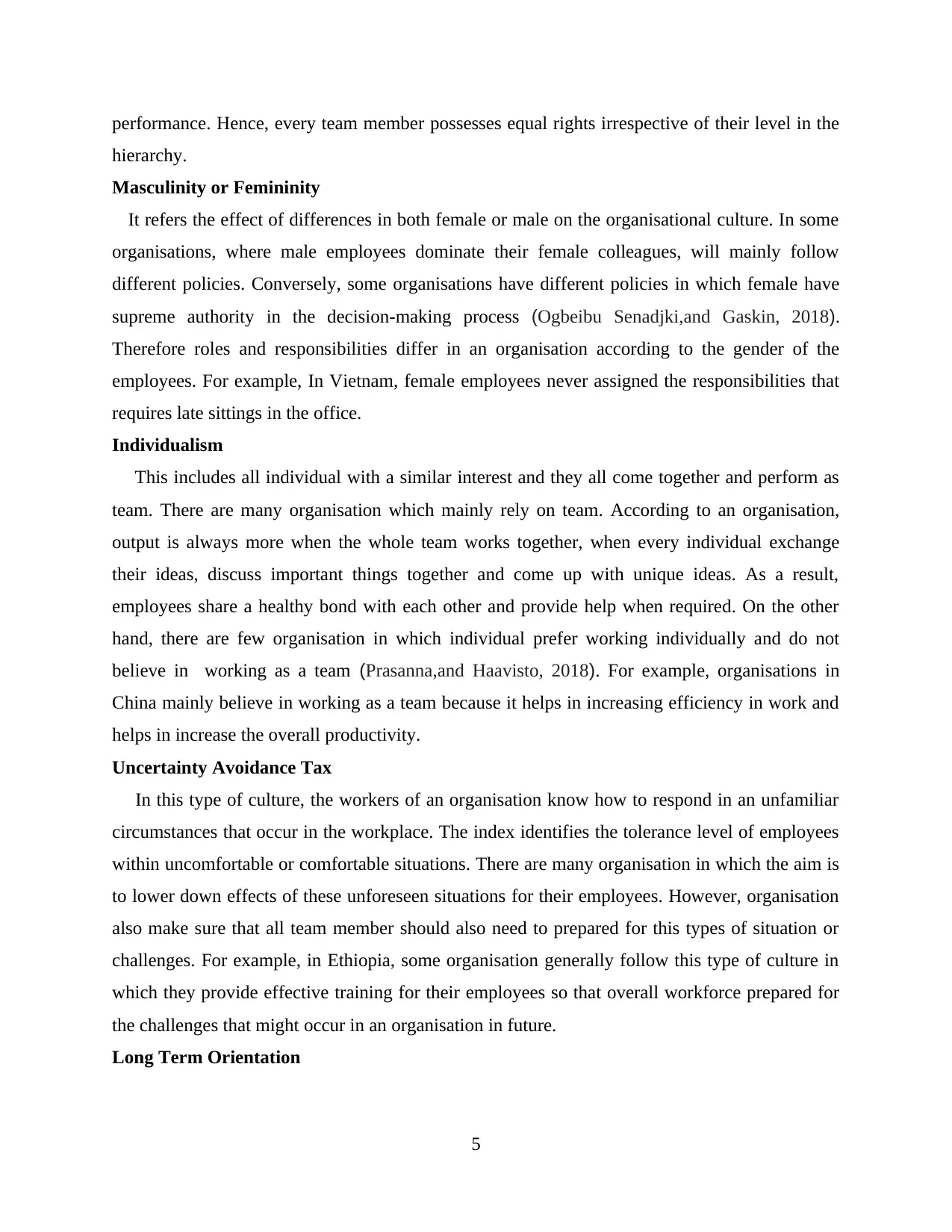
performance. Hence, every team member possesses equal rights irrespective of their level in the
hierarchy.
Masculinity or Femininity
It refers the effect of differences in both female or male on the organisational culture. In some
organisations, where male employees dominate their female colleagues, will mainly follow
different policies. Conversely, some organisations have different policies in which female have
supreme authority in the decision-making process (Ogbeibu Senadjki,and Gaskin, 2018).
Therefore roles and responsibilities differ in an organisation according to the gender of the
employees. For example, In Vietnam, female employees never assigned the responsibilities that
requires late sittings in the office.
Individualism
This includes all individual with a similar interest and they all come together and perform as
team. There are many organisation which mainly rely on team. According to an organisation,
output is always more when the whole team works together, when every individual exchange
their ideas, discuss important things together and come up with unique ideas. As a result,
employees share a healthy bond with each other and provide help when required. On the other
hand, there are few organisation in which individual prefer working individually and do not
believe in working as a team (Prasanna,and Haavisto, 2018). For example, organisations in
China mainly believe in working as a team because it helps in increasing efficiency in work and
helps in increase the overall productivity.
Uncertainty Avoidance Tax
In this type of culture, the workers of an organisation know how to respond in an unfamiliar
circumstances that occur in the workplace. The index identifies the tolerance level of employees
within uncomfortable or comfortable situations. There are many organisation in which the aim is
to lower down effects of these unforeseen situations for their employees. However, organisation
also make sure that all team member should also need to prepared for this types of situation or
challenges. For example, in Ethiopia, some organisation generally follow this type of culture in
which they provide effective training for their employees so that overall workforce prepared for
the challenges that might occur in an organisation in future.
Long Term Orientation
5
hierarchy.
Masculinity or Femininity
It refers the effect of differences in both female or male on the organisational culture. In some
organisations, where male employees dominate their female colleagues, will mainly follow
different policies. Conversely, some organisations have different policies in which female have
supreme authority in the decision-making process (Ogbeibu Senadjki,and Gaskin, 2018).
Therefore roles and responsibilities differ in an organisation according to the gender of the
employees. For example, In Vietnam, female employees never assigned the responsibilities that
requires late sittings in the office.
Individualism
This includes all individual with a similar interest and they all come together and perform as
team. There are many organisation which mainly rely on team. According to an organisation,
output is always more when the whole team works together, when every individual exchange
their ideas, discuss important things together and come up with unique ideas. As a result,
employees share a healthy bond with each other and provide help when required. On the other
hand, there are few organisation in which individual prefer working individually and do not
believe in working as a team (Prasanna,and Haavisto, 2018). For example, organisations in
China mainly believe in working as a team because it helps in increasing efficiency in work and
helps in increase the overall productivity.
Uncertainty Avoidance Tax
In this type of culture, the workers of an organisation know how to respond in an unfamiliar
circumstances that occur in the workplace. The index identifies the tolerance level of employees
within uncomfortable or comfortable situations. There are many organisation in which the aim is
to lower down effects of these unforeseen situations for their employees. However, organisation
also make sure that all team member should also need to prepared for this types of situation or
challenges. For example, in Ethiopia, some organisation generally follow this type of culture in
which they provide effective training for their employees so that overall workforce prepared for
the challenges that might occur in an organisation in future.
Long Term Orientation
5
Paraphrase This Document
Need a fresh take? Get an instant paraphrase of this document with our AI Paraphraser
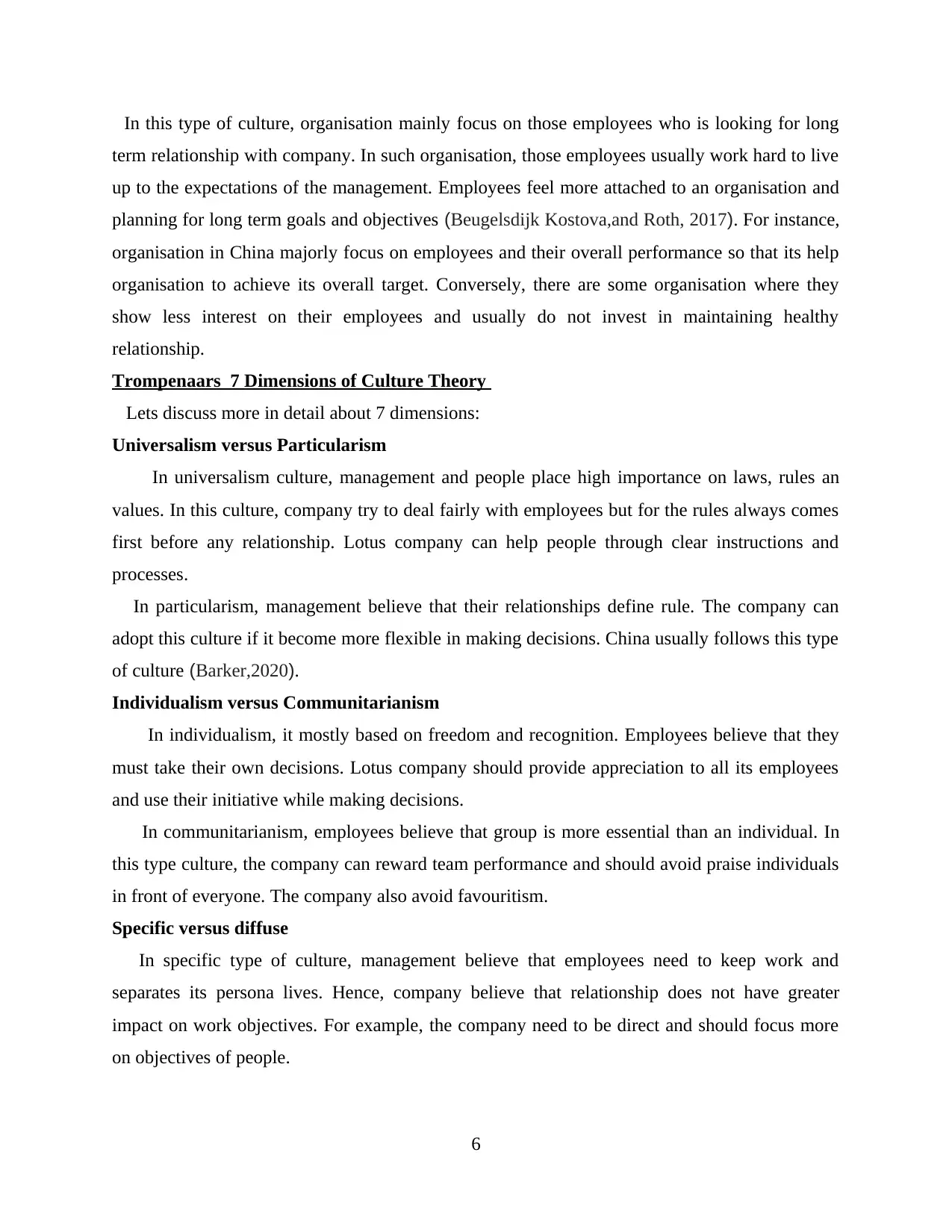
In this type of culture, organisation mainly focus on those employees who is looking for long
term relationship with company. In such organisation, those employees usually work hard to live
up to the expectations of the management. Employees feel more attached to an organisation and
planning for long term goals and objectives (Beugelsdijk Kostova,and Roth, 2017). For instance,
organisation in China majorly focus on employees and their overall performance so that its help
organisation to achieve its overall target. Conversely, there are some organisation where they
show less interest on their employees and usually do not invest in maintaining healthy
relationship.
Trompenaars 7 Dimensions of Culture Theory
Lets discuss more in detail about 7 dimensions:
Universalism versus Particularism
In universalism culture, management and people place high importance on laws, rules an
values. In this culture, company try to deal fairly with employees but for the rules always comes
first before any relationship. Lotus company can help people through clear instructions and
processes.
In particularism, management believe that their relationships define rule. The company can
adopt this culture if it become more flexible in making decisions. China usually follows this type
of culture (Barker,2020).
Individualism versus Communitarianism
In individualism, it mostly based on freedom and recognition. Employees believe that they
must take their own decisions. Lotus company should provide appreciation to all its employees
and use their initiative while making decisions.
In communitarianism, employees believe that group is more essential than an individual. In
this type culture, the company can reward team performance and should avoid praise individuals
in front of everyone. The company also avoid favouritism.
Specific versus diffuse
In specific type of culture, management believe that employees need to keep work and
separates its persona lives. Hence, company believe that relationship does not have greater
impact on work objectives. For example, the company need to be direct and should focus more
on objectives of people.
6
term relationship with company. In such organisation, those employees usually work hard to live
up to the expectations of the management. Employees feel more attached to an organisation and
planning for long term goals and objectives (Beugelsdijk Kostova,and Roth, 2017). For instance,
organisation in China majorly focus on employees and their overall performance so that its help
organisation to achieve its overall target. Conversely, there are some organisation where they
show less interest on their employees and usually do not invest in maintaining healthy
relationship.
Trompenaars 7 Dimensions of Culture Theory
Lets discuss more in detail about 7 dimensions:
Universalism versus Particularism
In universalism culture, management and people place high importance on laws, rules an
values. In this culture, company try to deal fairly with employees but for the rules always comes
first before any relationship. Lotus company can help people through clear instructions and
processes.
In particularism, management believe that their relationships define rule. The company can
adopt this culture if it become more flexible in making decisions. China usually follows this type
of culture (Barker,2020).
Individualism versus Communitarianism
In individualism, it mostly based on freedom and recognition. Employees believe that they
must take their own decisions. Lotus company should provide appreciation to all its employees
and use their initiative while making decisions.
In communitarianism, employees believe that group is more essential than an individual. In
this type culture, the company can reward team performance and should avoid praise individuals
in front of everyone. The company also avoid favouritism.
Specific versus diffuse
In specific type of culture, management believe that employees need to keep work and
separates its persona lives. Hence, company believe that relationship does not have greater
impact on work objectives. For example, the company need to be direct and should focus more
on objectives of people.
6
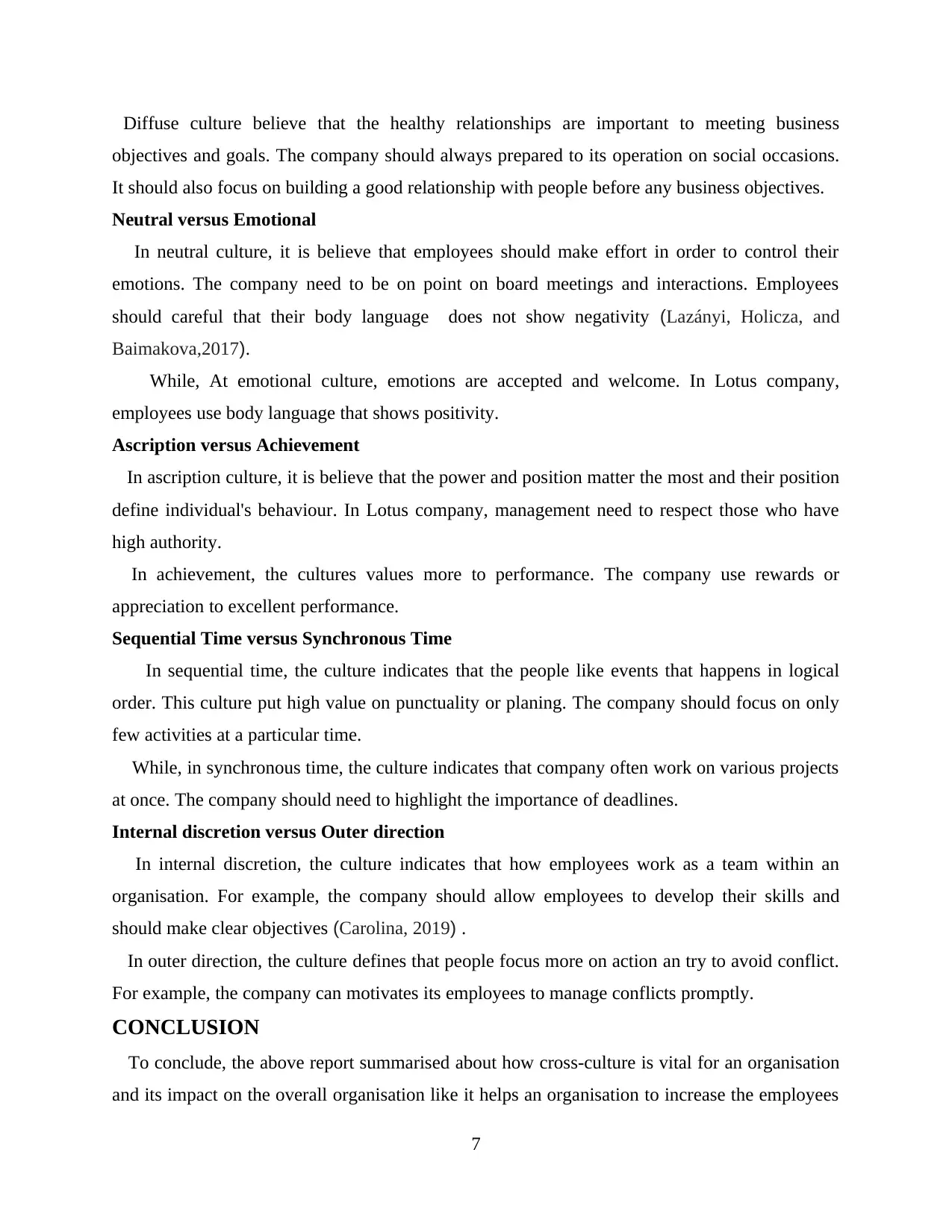
Diffuse culture believe that the healthy relationships are important to meeting business
objectives and goals. The company should always prepared to its operation on social occasions.
It should also focus on building a good relationship with people before any business objectives.
Neutral versus Emotional
In neutral culture, it is believe that employees should make effort in order to control their
emotions. The company need to be on point on board meetings and interactions. Employees
should careful that their body language does not show negativity (Lazányi, Holicza, and
Baimakova,2017).
While, At emotional culture, emotions are accepted and welcome. In Lotus company,
employees use body language that shows positivity.
Ascription versus Achievement
In ascription culture, it is believe that the power and position matter the most and their position
define individual's behaviour. In Lotus company, management need to respect those who have
high authority.
In achievement, the cultures values more to performance. The company use rewards or
appreciation to excellent performance.
Sequential Time versus Synchronous Time
In sequential time, the culture indicates that the people like events that happens in logical
order. This culture put high value on punctuality or planing. The company should focus on only
few activities at a particular time.
While, in synchronous time, the culture indicates that company often work on various projects
at once. The company should need to highlight the importance of deadlines.
Internal discretion versus Outer direction
In internal discretion, the culture indicates that how employees work as a team within an
organisation. For example, the company should allow employees to develop their skills and
should make clear objectives (Carolina, 2019) .
In outer direction, the culture defines that people focus more on action an try to avoid conflict.
For example, the company can motivates its employees to manage conflicts promptly.
CONCLUSION
To conclude, the above report summarised about how cross-culture is vital for an organisation
and its impact on the overall organisation like it helps an organisation to increase the employees
7
objectives and goals. The company should always prepared to its operation on social occasions.
It should also focus on building a good relationship with people before any business objectives.
Neutral versus Emotional
In neutral culture, it is believe that employees should make effort in order to control their
emotions. The company need to be on point on board meetings and interactions. Employees
should careful that their body language does not show negativity (Lazányi, Holicza, and
Baimakova,2017).
While, At emotional culture, emotions are accepted and welcome. In Lotus company,
employees use body language that shows positivity.
Ascription versus Achievement
In ascription culture, it is believe that the power and position matter the most and their position
define individual's behaviour. In Lotus company, management need to respect those who have
high authority.
In achievement, the cultures values more to performance. The company use rewards or
appreciation to excellent performance.
Sequential Time versus Synchronous Time
In sequential time, the culture indicates that the people like events that happens in logical
order. This culture put high value on punctuality or planing. The company should focus on only
few activities at a particular time.
While, in synchronous time, the culture indicates that company often work on various projects
at once. The company should need to highlight the importance of deadlines.
Internal discretion versus Outer direction
In internal discretion, the culture indicates that how employees work as a team within an
organisation. For example, the company should allow employees to develop their skills and
should make clear objectives (Carolina, 2019) .
In outer direction, the culture defines that people focus more on action an try to avoid conflict.
For example, the company can motivates its employees to manage conflicts promptly.
CONCLUSION
To conclude, the above report summarised about how cross-culture is vital for an organisation
and its impact on the overall organisation like it helps an organisation to increase the employees
7
⊘ This is a preview!⊘
Do you want full access?
Subscribe today to unlock all pages.

Trusted by 1+ million students worldwide
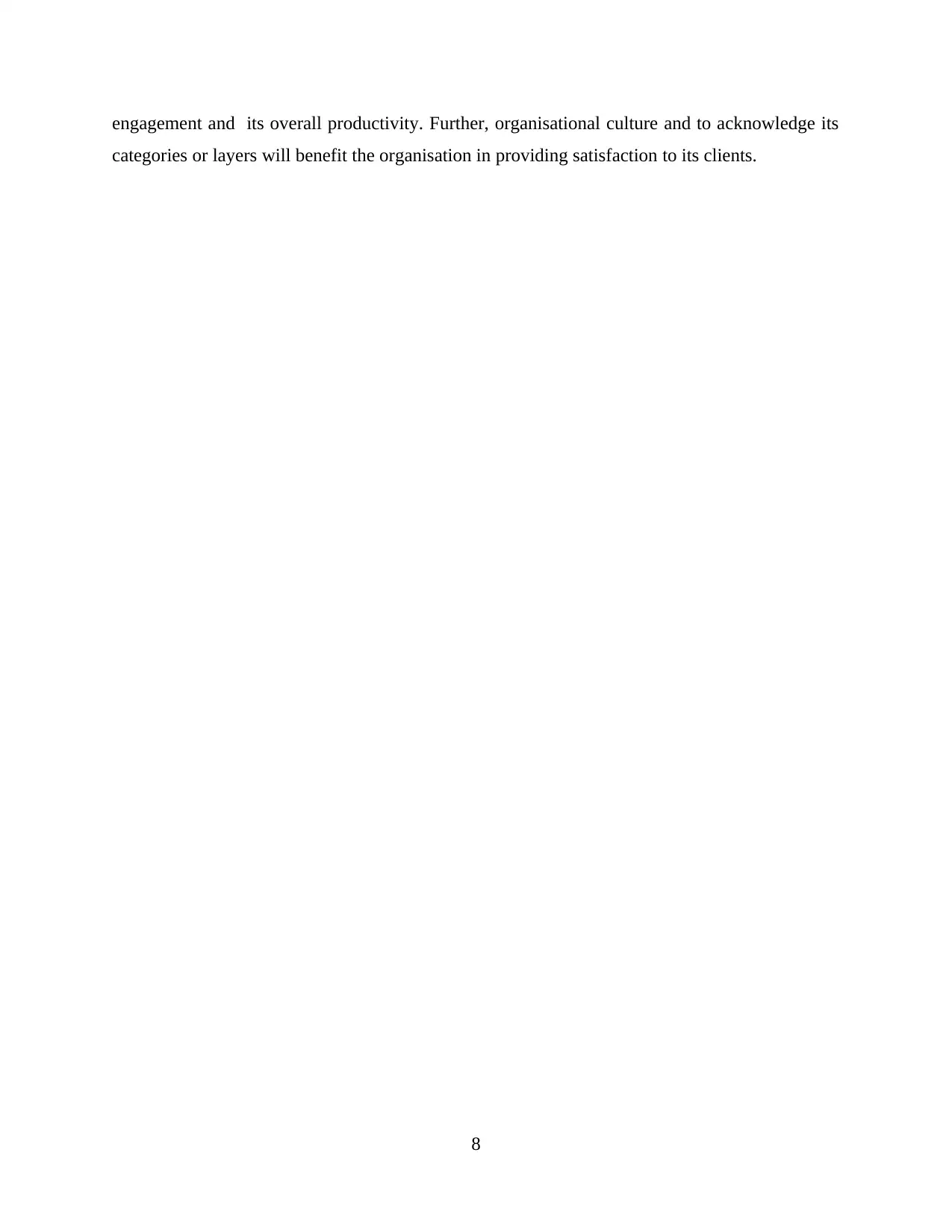
engagement and its overall productivity. Further, organisational culture and to acknowledge its
categories or layers will benefit the organisation in providing satisfaction to its clients.
8
categories or layers will benefit the organisation in providing satisfaction to its clients.
8
Paraphrase This Document
Need a fresh take? Get an instant paraphrase of this document with our AI Paraphraser
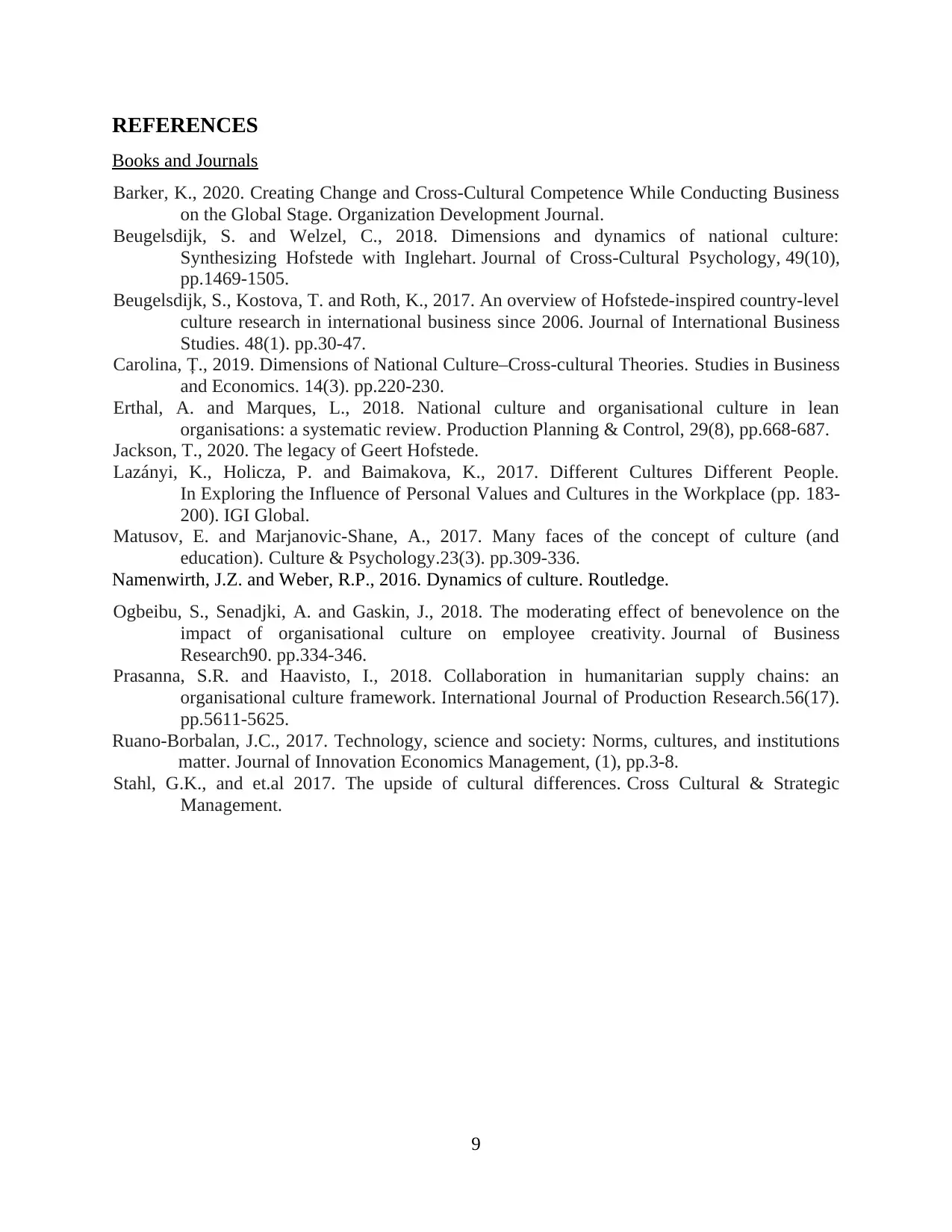
REFERENCES
Books and Journals
Barker, K., 2020. Creating Change and Cross-Cultural Competence While Conducting Business
on the Global Stage. Organization Development Journal.
Beugelsdijk, S. and Welzel, C., 2018. Dimensions and dynamics of national culture:
Synthesizing Hofstede with Inglehart. Journal of Cross-Cultural Psychology, 49(10),
pp.1469-1505.
Beugelsdijk, S., Kostova, T. and Roth, K., 2017. An overview of Hofstede-inspired country-level
culture research in international business since 2006. Journal of International Business
Studies. 48(1). pp.30-47.
Carolina, Ț., 2019. Dimensions of National Culture–Cross-cultural Theories. Studies in Business
and Economics. 14(3). pp.220-230.
Erthal, A. and Marques, L., 2018. National culture and organisational culture in lean
organisations: a systematic review. Production Planning & Control, 29(8), pp.668-687.
Jackson, T., 2020. The legacy of Geert Hofstede.
Lazányi, K., Holicza, P. and Baimakova, K., 2017. Different Cultures Different People.
In Exploring the Influence of Personal Values and Cultures in the Workplace (pp. 183-
200). IGI Global.
Matusov, E. and Marjanovic-Shane, A., 2017. Many faces of the concept of culture (and
education). Culture & Psychology.23(3). pp.309-336.
Namenwirth, J.Z. and Weber, R.P., 2016. Dynamics of culture. Routledge.
Ogbeibu, S., Senadjki, A. and Gaskin, J., 2018. The moderating effect of benevolence on the
impact of organisational culture on employee creativity. Journal of Business
Research90. pp.334-346.
Prasanna, S.R. and Haavisto, I., 2018. Collaboration in humanitarian supply chains: an
organisational culture framework. International Journal of Production Research.56(17).
pp.5611-5625.
Ruano-Borbalan, J.C., 2017. Technology, science and society: Norms, cultures, and institutions
matter. Journal of Innovation Economics Management, (1), pp.3-8.
Stahl, G.K., and et.al 2017. The upside of cultural differences. Cross Cultural & Strategic
Management.
9
Books and Journals
Barker, K., 2020. Creating Change and Cross-Cultural Competence While Conducting Business
on the Global Stage. Organization Development Journal.
Beugelsdijk, S. and Welzel, C., 2018. Dimensions and dynamics of national culture:
Synthesizing Hofstede with Inglehart. Journal of Cross-Cultural Psychology, 49(10),
pp.1469-1505.
Beugelsdijk, S., Kostova, T. and Roth, K., 2017. An overview of Hofstede-inspired country-level
culture research in international business since 2006. Journal of International Business
Studies. 48(1). pp.30-47.
Carolina, Ț., 2019. Dimensions of National Culture–Cross-cultural Theories. Studies in Business
and Economics. 14(3). pp.220-230.
Erthal, A. and Marques, L., 2018. National culture and organisational culture in lean
organisations: a systematic review. Production Planning & Control, 29(8), pp.668-687.
Jackson, T., 2020. The legacy of Geert Hofstede.
Lazányi, K., Holicza, P. and Baimakova, K., 2017. Different Cultures Different People.
In Exploring the Influence of Personal Values and Cultures in the Workplace (pp. 183-
200). IGI Global.
Matusov, E. and Marjanovic-Shane, A., 2017. Many faces of the concept of culture (and
education). Culture & Psychology.23(3). pp.309-336.
Namenwirth, J.Z. and Weber, R.P., 2016. Dynamics of culture. Routledge.
Ogbeibu, S., Senadjki, A. and Gaskin, J., 2018. The moderating effect of benevolence on the
impact of organisational culture on employee creativity. Journal of Business
Research90. pp.334-346.
Prasanna, S.R. and Haavisto, I., 2018. Collaboration in humanitarian supply chains: an
organisational culture framework. International Journal of Production Research.56(17).
pp.5611-5625.
Ruano-Borbalan, J.C., 2017. Technology, science and society: Norms, cultures, and institutions
matter. Journal of Innovation Economics Management, (1), pp.3-8.
Stahl, G.K., and et.al 2017. The upside of cultural differences. Cross Cultural & Strategic
Management.
9

10
⊘ This is a preview!⊘
Do you want full access?
Subscribe today to unlock all pages.

Trusted by 1+ million students worldwide
1 out of 14
Related Documents
Your All-in-One AI-Powered Toolkit for Academic Success.
+13062052269
info@desklib.com
Available 24*7 on WhatsApp / Email
![[object Object]](/_next/static/media/star-bottom.7253800d.svg)
Unlock your academic potential
Copyright © 2020–2025 A2Z Services. All Rights Reserved. Developed and managed by ZUCOL.





